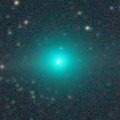
|
Now it is 6.4 mag (Feb. 1, Juan Jose Gonzalez). It is expected to reach to 5 mag in February. It keeps observable in the excellent condition long time around the highlight until spring. Because it moves along the ecliptic plane, the anti-tail is clearly visible.
Date(TT) R.A. (2000) Decl. Delta r Elong. m1 Best Time(A, h)
Jan. 31 15 17.40 -17 22.9 0.973 1.253 79 6.5 5:33 (341, 35)
Feb. 7 14 47.92 -15 23.3 0.757 1.285 94 6.1 5:28 (356, 39)
|

|
It has brightened much faster than expected. Now it is so bright as 8.4 mag (Jan. 30, Juan Jose Gonzalez). Very large and visible through binoculars. It keeps bright as 9 mag locating high in the evening sky, observable in good condition until February. Then it keeps observable for a long time until early summer.
Date(TT) R.A. (2000) Decl. Delta r Elong. m1 Best Time(A, h)
Jan. 31 4 21.41 16 11.6 0.712 1.440 115 9.0 19:39 ( 0, 71)
Feb. 7 4 38.52 16 31.8 0.748 1.444 112 9.2 19:29 ( 0, 72)
|

|
It was expected to reach up to 7 mag and to be observable in good condition in winter. But finally, the comet has never been recovered after all. This comet has not been observed since 1986. It was not detected, fainter than 20 mag on Dec. 1 (Takaaki Oribe). So it will be much fainter than expected, maybe already disappeared.
Date(TT) R.A. (2000) Decl. Delta r Elong. m1 Best Time(A, h)
Jan. 31 1 56.44 17 41.9 1.010 1.312 82 9.7 18:54 ( 58, 62)
Feb. 7 2 27.00 20 2.8 1.069 1.360 82 10.5 19:00 ( 63, 63)
|

|
Brightening very rapidly, faster than expected. It is already so bright as 9.8 mag (Jan. 16, Juan Jose Gonzalez). It is expected to reach to 8 mag in 2009 summer. It becomes low tempporarily in February and March. But then it will be observable at 8-10 mag in good condition for a long time until late autumn.
Date(TT) R.A. (2000) Decl. Delta r Elong. m1 Best Time(A, h)
Jan. 31 22 13.94 38 27.7 3.876 3.472 58 9.9 18:54 (119, 27)
Feb. 7 22 17.99 37 22.4 3.924 3.444 54 9.9 19:00 (121, 22)
|

|
Now it is bright as 9.8 mag (Jan. 16, Juan Jose Gonzalez). It will be fading slowly after this. It keeps visible visually for a long time until June when it becomes low in the evening at 13 mag.
Date(TT) R.A. (2000) Decl. Delta r Elong. m1 Best Time(A, h)
Jan. 31 5 56.15 49 2.1 2.096 2.853 132 10.8 21:13 (180, 76)
Feb. 7 5 57.39 47 11.6 2.188 2.893 127 10.9 20:47 (180, 78)
|
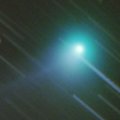
|
It reached to 6.3 mag in September in the southern sky (Sept. 4, Marco Goiato). Now it is still bright as 10.0 mag (Jan. 13, U. Pilz). It keeps observable in the northern sky while fading gradually. In the Southern Hemisphere, it will never be observable again.
Date(TT) R.A. (2000) Decl. Delta r Elong. m1 Best Time(A, h)
Jan. 31 19 50.96 35 28.1 2.579 2.170 54 11.1 5:33 (242, 24)
Feb. 7 20 5.16 38 36.2 2.633 2.252 56 11.4 5:28 (240, 26)
|
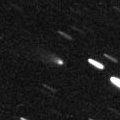
|
Brightening very rapidly, faster than expected. Now it is bright as 11.5 mag (Jan. 16, Juan Jose Gonzalez), already visible visually. It keeps 11 mag and observable in the evening sky for a long time until May.
Date(TT) R.A. (2000) Decl. Delta r Elong. m1 Best Time(A, h)
Jan. 31 0 8.46 -0 21.4 1.670 1.294 50 12.1 18:54 ( 66, 30)
Feb. 7 0 29.41 2 31.6 1.670 1.274 49 11.9 19:00 ( 70, 30)
|
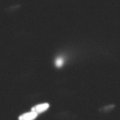
|
Already very bright as 11.7 mag (Feb. 1, Marco Goiato). It is expected to brighten up to 10 mag from late 2009 to early 2010. Good condition in the Southern Hemisphere. In the Northern Hemisphere, it is observable in the evening low sky from February to April. Then it becomes unobservable until September. But after October, it is observable at 10 mag for a while in good condition. In the Southern Hemisphere, it keeps observable for a long time while brightening until June when it brightens to 11 mag. But it becomes unobservable around and after the brightest time.
Date(TT) R.A. (2000) Decl. Delta r Elong. m1 Best Time(A, h)
Jan. 31 5 16.52 -47 50.4 3.248 3.533 98 12.3 20:33 ( 0, 7)
Feb. 7 5 14.74 -45 57.7 3.216 3.479 97 12.3 20:04 ( 0, 9)
|

|
It brightened up to 11.5 mag in summer (Aug. 4, Marco Goiato). Although it is not observable in the Northern Hemisphere, it keeps observable in good condition for a long time in the Southern Hemisphere. However, no visual observations have been reported since last summer. Recent CCD observations suggest that it is still visible visually around 12-13 mag.
Date(TT) R.A. (2000) Decl. Delta r Elong. m1 Best Time(A, h)
Jan. 31 20 40.59 -75 10.7 3.162 2.765 57 12.4 5:33 (342,-35)
Feb. 7 21 39.44 -75 51.2 3.136 2.787 60 12.4 19:00 ( 17,-35)
|

|
Now it is 13.5 mag, already visible visually (Jan. 31, Alan Hale). It will be bright at 9-10 mag for a long time from spring to autumn.
Date(TT) R.A. (2000) Decl. Delta r Elong. m1 Best Time(A, h)
Jan. 31 16 32.83 -17 47.8 2.189 1.932 61 13.0 5:33 (322, 28)
Feb. 7 16 50.67 -18 18.7 2.093 1.896 64 12.7 5:28 (324, 28)
|
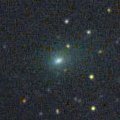
|
First return of a bright new periodic comet discovered by SOHO spacecraft in 2003. Now it was re-discovered by STEREO-B spacecraft. Now it is bright as 11.2 mag (Jan. 16, Ken-ichi Kadota), but fainter than originally expected by 1 or 2 mag. It keeps observable in good condition while fading gradually after this.
Date(TT) R.A. (2000) Decl. Delta r Elong. m1 Best Time(A, h)
Jan. 31 16 10.53 -6 6.6 0.667 0.983 70 13.0 5:33 (320, 40)
Feb. 7 16 7.08 -4 47.2 0.699 1.084 78 13.7 5:28 (327, 45)
|

|
Now it is 14.3 mag (Jan. 8, Alan Hale), a bit fainter than expected, but already visible visually. It will to be observable at 12-13 mag for a long time from January to July.
Date(TT) R.A. (2000) Decl. Delta r Elong. m1 Best Time(A, h)
Jan. 31 9 52.90 18 26.9 1.501 2.469 166 13.3 1:13 ( 0, 73)
Feb. 7 9 47.55 18 52.9 1.466 2.448 173 13.1 0:40 ( 0, 74)
|

|
Now it is 13.3 mag, and visible visually (Jan. 16, Juan Jose Gonzalez). It will reach to 10-11 mag in June. In the Northern Hemisphere, it keeps observable in good condition until May when it becomes brightest. But it will never be observable again after that. In the Southern Hemisphere, it is not observable until April. But after that, it will be observable while fading gradually.
Date(TT) R.A. (2000) Decl. Delta r Elong. m1 Best Time(A, h)
Jan. 31 2 13.52 71 29.1 1.841 2.280 103 13.4 18:54 (170, 52)
Feb. 7 2 33.38 68 32.2 1.807 2.202 99 13.2 19:00 (165, 54)
|

|
It reached to 10.9 mag in May (May 11, Marco Goiato). It is fading slowly. Now it is 13.3 mag (Jan. 27, Katsumi Yoshimoto). It keeps bright as 13-14 mag for a long time after this until summer.
Date(TT) R.A. (2000) Decl. Delta r Elong. m1 Best Time(A, h)
Jan. 31 16 18.05 10 8.7 3.641 3.493 73 13.3 5:33 (304, 52)
Feb. 7 16 24.74 11 43.2 3.596 3.535 78 13.3 5:28 (307, 56)
|

|
New outburst occured in late December, and it still looks bright as 10.8 mag (Jan. 20, Osamu Miyazaki). In addition, the remnant of the major outburst in late September is still visible. Under the excellent condition, the huge faint coma expading up to 9 arcmin is also visible.
Date(TT) R.A. (2000) Decl. Delta r Elong. m1 Best Time(A, h)
Jan. 31 7 53.99 23 40.7 5.146 6.101 164 13.4 23:10 ( 0, 79)
Feb. 7 7 50.67 23 43.0 5.184 6.103 156 13.5 22:39 ( 0, 79)
|
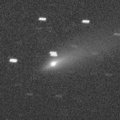
|
It reached up to 9.6 mag in summer (Aug. 2, Juan Jose Gonzalez). Now it is fading. It has already faded down to 14.0 mag (Feb. 1, Ken-ichi Kadota). It keeps observable and fading in the morning sky after this. It will be visible visually for some more time.
Date(TT) R.A. (2000) Decl. Delta r Elong. m1 Best Time(A, h)
Jan. 31 13 52.97 32 34.8 1.869 2.417 111 14.5 5:12 ( 0, 88)
Feb. 7 13 53.58 33 53.6 1.859 2.467 116 14.6 4:45 ( 0, 89)
|
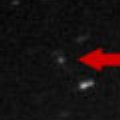
|
It had been observed until mid January in the evening low sky. It reached up to 14.1 mag (Jan. 11, Ken-ichi Kadota). Now it is not observable. It will be observable again in summer, but it will be fainter than 17 mag.
Date(TT) R.A. (2000) Decl. Delta r Elong. m1 Best Time(A, h)
Jan. 31 21 51.46 -10 16.4 2.691 1.762 15 14.6 18:54 ( 79, -3)
Feb. 7 22 10.83 -9 0.4 2.713 1.768 13 14.6 19:00 ( 82, -5)
|

|
Now it is 14.2 mag (Jan. 9, Ken-ichi Kadota). It had been bright and visible visually around 13 mag from spring to autumn in 2008. It will be visible visually at 14 mag again until summer.
Date(TT) R.A. (2000) Decl. Delta r Elong. m1 Best Time(A, h)
Jan. 31 15 17.07 24 53.0 6.112 6.230 92 14.7 5:33 (302, 73)
Feb. 7 15 15.32 25 58.8 6.034 6.252 98 14.7 5:28 (315, 78)
|
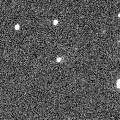
|
Now it is 15.6 mag (Jan. 10, Ken-ichi Kadota). It will brighten up to 12-13 mag in 2010 summer. It reaches to 14.5 mag in 2009 spring, and keeps observable in good condition until 2009 summer.
Date(TT) R.A. (2000) Decl. Delta r Elong. m1 Best Time(A, h)
Jan. 31 12 41.25 9 22.9 2.631 3.290 124 15.1 4:01 ( 0, 64)
Feb. 7 12 41.23 9 46.1 2.533 3.269 131 15.0 3:33 ( 0, 65)
|

|
It brightened up to 12.7 mag in 2008 spring (Apr. 12, Marco Goiato). But it faded down to 14.9 mag in July (July 22, Mitsunori Tsumura). No observations have been reported for a long time since last summer. But in the Southern Hemisphere, it has appeared in the morning sky, and it will be observable in good condition after this. It will never be observable again in the Northern Hemisphere.
Date(TT) R.A. (2000) Decl. Delta r Elong. m1 Best Time(A, h)
Jan. 31 18 4.36 -44 21.1 4.011 3.380 44 15.0 5:33 (323, -5)
Feb. 7 18 18.01 -44 54.5 3.982 3.413 48 15.0 5:28 (324, -4)
|

|
Now it is 16.2 mag (Jan. 10, Ken-ichi Kadota). It will be observable at 15-16 mag in good condition until spring.
Date(TT) R.A. (2000) Decl. Delta r Elong. m1 Best Time(A, h)
Jan. 31 9 31.97 22 52.6 2.639 3.612 169 15.3 0:52 ( 0, 78)
Feb. 7 9 27.23 23 21.3 2.629 3.608 171 15.2 0:20 ( 0, 78)
|
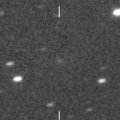
|
It must have been fainter than 18 mag, however, an outburst occured unexpectedly on Jan. 30 and it brightened up to 15.2 mag (Catalina Sky Survey).
Date(TT) R.A. (2000) Decl. Delta r Elong. m1 Best Time(A, h)
Jan. 31 11 44.46 38 11.6 1.816 2.628 137 15.3 3:04 (180, 87)
Feb. 7 11 40.93 39 15.1 1.813 2.657 141 16.2 2:33 (180, 86)
|

|
Now it is 15.7 mag (Feb. 1, Ken-ichi Kadota). It will be observable at 15 mag in good condition in spring.
Date(TT) R.A. (2000) Decl. Delta r Elong. m1 Best Time(A, h)
Jan. 31 12 43.06 14 23.2 1.837 2.535 125 15.9 4:02 ( 0, 69)
Feb. 7 12 42.56 14 8.8 1.751 2.517 131 15.7 3:34 ( 0, 69)
|

|
Now it is 16.2 mag (Jan. 3, Ken-ichi Kadota). It should have reached up to 14.5 mag in summer in the southern sky, but it is already fading. It keeps observable while the comet will be fading slowly after this.
Date(TT) R.A. (2000) Decl. Delta r Elong. m1 Best Time(A, h)
Jan. 31 12 15.03 -24 21.7 3.004 3.544 115 16.0 3:35 ( 0, 31)
Feb. 7 12 10.90 -23 2.3 2.951 3.593 123 16.0 3:03 ( 0, 32)
|

|
Now it is 16.4 mag (Jan. 1, Ken-ichi Kadota). It will be getting fainter and lower in the evening sky. It becomes unobservable in May.
Date(TT) R.A. (2000) Decl. Delta r Elong. m1 Best Time(A, h)
Jan. 31 2 35.08 25 10.3 2.104 2.372 93 16.1 18:54 ( 57, 74)
Feb. 7 2 44.96 25 19.6 2.180 2.366 88 16.2 19:00 ( 68, 69)
|

|
Now it is 16.3 mag (Jan. 17, Ken-ichi Kadota). It will be fading slowly after this, and will be fainter than 18 mag in March.
Date(TT) R.A. (2000) Decl. Delta r Elong. m1 Best Time(A, h)
Jan. 31 23 28.12 32 4.2 2.351 2.075 61 16.4 18:54 (105, 39)
Feb. 7 23 50.00 32 40.7 2.427 2.107 59 16.5 19:00 (107, 37)
|
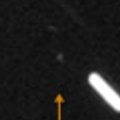
|
Now it is 16.9 mag (Jan. 22, P. C. Sherrod). It will brighten rapidly and will be observable at 16.5 mag from February to April. It moves southwards very fast after early April, and will be unobservable very soon in the Northern Hemisphere.
Date(TT) R.A. (2000) Decl. Delta r Elong. m1 Best Time(A, h)
Jan. 31 11 44.58 59 37.2 0.547 1.390 127 16.8 3:03 (180, 66)
Feb. 7 12 15.45 64 15.0 0.497 1.324 122 16.6 3:06 (180, 61)
|
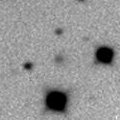
|
At the discovery in 2001, it became much brighter after the perihelion passage. In this apparition, although it was so faint as 20 mag in early September, it brightened very rapidly, and it reached up to 16.4 mag (Jan. 25, Catalina Sky Survey). It keeps observable in good condition for a while after this. But it will fade out rapidly after this, and will be fainter than 18 mag in April.
Date(TT) R.A. (2000) Decl. Delta r Elong. m1 Best Time(A, h)
Jan. 31 8 24.68 23 23.5 1.012 1.991 170 16.7 23:41 ( 0, 78)
Feb. 7 8 21.09 24 7.9 1.040 2.004 163 16.8 23:10 ( 0, 79)
|

|
It reached up to 8.5 mag in September (Sept. 24, Juan Jose Gonzalez). Now it is fading very rapidly. It has already faded down to 15.3 mag (Jan. 16, Mitsunori Tsumura). It will be fainter than 18 mag in February.
Date(TT) R.A. (2000) Decl. Delta r Elong. m1 Best Time(A, h)
Jan. 31 1 51.79 -8 36.1 2.318 2.232 72 16.9 18:54 ( 35, 40)
Feb. 7 2 2.97 -6 54.0 2.440 2.281 69 17.5 19:00 ( 42, 39)
|
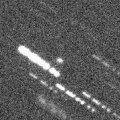
|
Now it is 17.0 mag (Jan. 12, Ken-ichi Kadota). It will be observable at 16.5 mag in good condition in 2009 spring.
Date(TT) R.A. (2000) Decl. Delta r Elong. m1 Best Time(A, h)
Jan. 31 17 37.51 23 38.7 3.287 2.976 63 17.0 5:33 (270, 45)
Feb. 7 17 36.30 24 24.4 3.210 2.984 68 17.0 5:28 (273, 50)
|

|
Brightening rapidly than expected. It reached up to 17.2 mag (Jan. 20, Yasukazu Ikari). It will keep 17 mag until February, and will be observable in good condition until April when it becomes fainter than 18 mag.
Date(TT) R.A. (2000) Decl. Delta r Elong. m1 Best Time(A, h)
Jan. 31 10 9.86 15 27.7 0.676 1.641 161 17.1 1:30 ( 0, 70)
Feb. 7 10 6.64 14 29.3 0.666 1.646 169 17.1 0:59 ( 0, 69)
|

|
It keeps observable at 17.5 mag until spring. But it locates low in the Northern Hemispere.
Date(TT) R.A. (2000) Decl. Delta r Elong. m1 Best Time(A, h)
Jan. 31 8 34.41 -24 28.8 3.656 4.435 137 17.3 23:50 ( 0, 30)
Feb. 7 8 29.99 -24 37.8 3.654 4.437 137 17.3 23:18 ( 0, 30)
|

|
Peculiar asteroid moving along a cometary orbit. It will be observable around 17 mag in good condition for a long time until May. It will fade out very rapidly after May.
Date(TT) R.A. (2000) Decl. Delta r Elong. m1 Best Time(A, h)
Jan. 31 14 21.92 -3 30.1 1.326 1.741 96 17.3 5:33 (357, 51)
Feb. 7 14 29.63 -3 56.1 1.297 1.781 101 17.3 5:21 ( 0, 51)
|
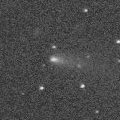
|
It reached up to 13.7 mag and became visible visually (Nov. 6, Juan Jose Gonzalez). However, it is already fading. It has faded down to 17.0 mag (Jan. 14, Ken-ichi Kadota). It will be fainter than 18 mag in February.
Date(TT) R.A. (2000) Decl. Delta r Elong. m1 Best Time(A, h)
Jan. 31 3 28.40 11 26.8 1.981 2.381 101 17.5 18:54 ( 5, 66)
Feb. 7 3 35.82 12 13.6 2.087 2.405 96 17.7 19:00 ( 21, 66)
|
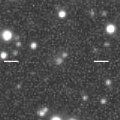
|
Now it is 17.6 mag (Jan. 10, Ken-ichi Kadota). It keeps observable in good condition at 17.5-18 mag until March.
Date(TT) R.A. (2000) Decl. Delta r Elong. m1 Best Time(A, h)
Jan. 31 4 51.65 11 30.6 1.783 2.443 121 17.6 20:08 ( 0, 67)
Feb. 7 4 53.16 12 48.4 1.847 2.432 114 17.7 19:43 ( 0, 68)
|
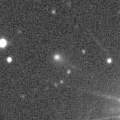
|
It was observed as bright as 14-15 mag in 2007 autumn. Now it is 18.2 mag (Jan. 24, Ken-ichi Kadota). It keeps observable in good condition for a while. It will be fainter than 18 mag in Feburary.
Date(TT) R.A. (2000) Decl. Delta r Elong. m1 Best Time(A, h)
Jan. 31 7 43.11 34 7.3 2.711 3.638 156 17.7 22:59 ( 0, 89)
Feb. 7 7 38.14 33 58.3 2.777 3.664 150 17.8 22:27 ( 0, 89)
|

|
Now it is 17.6 mag (Jan. 24, Ken-ichi Kadota). It will reach to 15 mag in 2010. It keeps observable for a long time after this in the Northern Hemisphere.
Date(TT) R.A. (2000) Decl. Delta r Elong. m1 Best Time(A, h)
Jan. 31 15 34.05 -7 56.1 6.670 6.540 78 17.8 5:33 (332, 43)
Feb. 7 15 36.46 -7 26.9 6.520 6.503 84 17.7 5:28 (339, 45)
|

|
It reached up to 16.5 mag in autumn (Nov. 1, Catalina Sky Survey). Now it is fading. It has already faded down to 17.6 mag (Jan. 3, Ken-ichi Kadota). It will be fainter than 18 mag in February.
Date(TT) R.A. (2000) Decl. Delta r Elong. m1 Best Time(A, h)
Jan. 31 4 15.02 24 13.1 2.646 3.191 115 17.8 19:32 ( 0, 79)
Feb. 7 4 17.42 24 4.8 2.769 3.220 108 17.9 19:07 ( 0, 79)
|

|
Diffuse comet, but it brightened up to 9.8 mag on July 7 (Juan Jose Gonzalez). Now it is fading. It was still visible visually at 14.8 mag on Dec. 20 (Jose Carvajal). However, it has already faded down to 17.5 mag (Jan. 16, Ken-ichi Kadota). It will be fainter than 18 mag soon.
Date(TT) R.A. (2000) Decl. Delta r Elong. m1 Best Time(A, h)
Jan. 31 3 1.19 49 4.4 2.611 3.008 104 17.8 18:54 (158, 75)
Feb. 7 3 10.21 46 58.8 2.758 3.072 99 18.0 19:00 (141, 74)
|
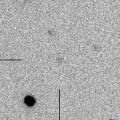
|
It was observed at 18 mag from autumn to winter in 2007. It will be observable again at 18 mag from winter to spring in 2009.
Date(TT) R.A. (2000) Decl. Delta r Elong. m1 Best Time(A, h)
Jan. 31 10 39.95 -6 9.9 4.776 5.610 144 17.9 2:00 ( 0, 49)
Feb. 7 10 37.44 -6 14.9 4.728 5.615 151 17.9 1:30 ( 0, 49)
|

|
Now it should be brightest. But it has not been recovered yet. It was observed only around the perihelion at the discovery in 1999. If it was bright temporarily in outburst, it can be much fainter than this ephemeris in this apparition. Josef Mueller reported it was 19.2 mag on Dec. 16, 2007, but it was not confirmed. It was not detected, fainter than 19.2 mag on Dec. 20 (James R. Schofer) and fainter than 20.5 mag on Jan. 15 (Leonid Elenin).
Date(TT) R.A. (2000) Decl. Delta r Elong. m1 Best Time(A, h)
Jan. 31 6 0.73 23 54.7 2.515 3.322 139 17.9 21:17 ( 0, 79)
Feb. 7 5 59.13 23 45.5 2.588 3.325 131 18.0 20:48 ( 0, 79)
|

|
Great outburst occured in 2007 October, and it bacame a naked eye comet of 2 mag. It kept so bright as 5.5 mag still in 2008 spring (Apr. 30, Carlos Labordena), but it was extremely faint and difficult to see. The size was so large, the diameter was larger than 60 arcmin. Now it became observable in good condition again. The extremely faint large diffuse glow may be detected with a best sky condition, around 5-6 mag with a diameter of 1 or 2 degrees. Mitsunori Tsumura detected a possible glow of Comet Holmes on Nov. 4. Current brightness of the central core is 16.9 mag (Jan. 25, Catalina Sky Survey), much brighter than pre-outburst brightness still now.
Date(TT) R.A. (2000) Decl. Delta r Elong. m1 Best Time(A, h)
Jan. 31 8 45.40 26 47.3 3.279 4.254 170 18.7 0:06 ( 0, 82)
Feb. 7 8 39.47 26 49.4 3.315 4.275 164 18.7 23:28 ( 0, 82)
|

|
It was observed bright at 16.5-17 mag from late 2006 to early 2007. However, it is fading after that, although it is getting closer to the sun. It was so faint as 19.4 mag around the perihelion passage in 2008 spring (Mar. 10, Mitsunori Tsumura). This comet was observed so faint around the perihelion passage in the previous apparition at the discovery. It faded out before the perihelion passage again in this apparition. No observations have been reported since 2008 April at all.
Date(TT) R.A. (2000) Decl. Delta r Elong. m1 Best Time(A, h)
Jan. 31 11 52.90 20 13.5 3.573 4.353 137 21.6 3:12 ( 0, 75)
Feb. 7 11 51.35 20 52.9 3.522 4.361 144 21.6 2:43 ( 0, 76)
|
|
![]()
 C/2006 W3 ( Christensen )
C/2006 W3 ( Christensen ) C/2006 OF2 ( Broughton )
C/2006 OF2 ( Broughton ) C/2008 A1 ( McNaught )
C/2008 A1 ( McNaught ) 67P/Churyumov-Gerasimenko
67P/Churyumov-Gerasimenko C/2007 Q3 ( Siding Spring )
C/2007 Q3 ( Siding Spring ) C/2007 G1 ( LINEAR )
C/2007 G1 ( LINEAR ) 22P/Kopff
22P/Kopff 210P/2008 X4 ( Christensen )
210P/2008 X4 ( Christensen ) 116P/Wild 4
116P/Wild 4 C/2008 T2 ( Cardinal )
C/2008 T2 ( Cardinal ) C/2006 Q1 ( McNaught )
C/2006 Q1 ( McNaught ) 29P/Schwassmann-Wachmann 1
29P/Schwassmann-Wachmann 1 19P/Borrelly
19P/Borrelly 68P/Klemola
68P/Klemola C/2005 L3 ( McNaught )
C/2005 L3 ( McNaught ) 65P/Gunn
65P/Gunn C/2007 B2 ( Skiff )
C/2007 B2 ( Skiff ) 74P/Smirnova-Chernykh
74P/Smirnova-Chernykh 33P/Daniel
33P/Daniel 77P/Longmore
77P/Longmore C/2006 U6 ( Spacewatch )
C/2006 U6 ( Spacewatch ) 59P/Kearns-Kwee
59P/Kearns-Kwee C/2008 R3 ( LINEAR )
C/2008 R3 ( LINEAR ) 209P/2008 X2 ( LINEAR )
209P/2008 X2 ( LINEAR ) 204P/2008 R5 ( LINEAR-NEAT )
204P/2008 R5 ( LINEAR-NEAT ) 6P/d'Arrest
6P/d'Arrest C/2008 Q1 ( Maticic )
C/2008 Q1 ( Maticic ) P/2008 Y2 ( Gibbs )
P/2008 Y2 ( Gibbs ) P/2008 Y3 ( McNaught )
P/2008 Y3 ( McNaught ) 2001 TX16
2001 TX16 61P/Shajn-Schaldach
61P/Shajn-Schaldach 211P/2008 X1 ( Hill )
211P/2008 X1 ( Hill ) 188P/2007 J7 ( LINEAR-Mueller )
188P/2007 J7 ( LINEAR-Mueller ) C/2008 FK75 ( Lemmon-Siding Spring )
C/2008 FK75 ( Lemmon-Siding Spring ) 44P/Reinmuth 2
44P/Reinmuth 2 C/2008 J1 ( Boattini )
C/2008 J1 ( Boattini ) C/2007 S2 ( Lemmon )
C/2007 S2 ( Lemmon ) P/1999 XN120 ( Catalina )
P/1999 XN120 ( Catalina ) 17P/Holmes
17P/Holmes 173P/2005 T1 ( Mueller 5 )
173P/2005 T1 ( Mueller 5 )![]()


































